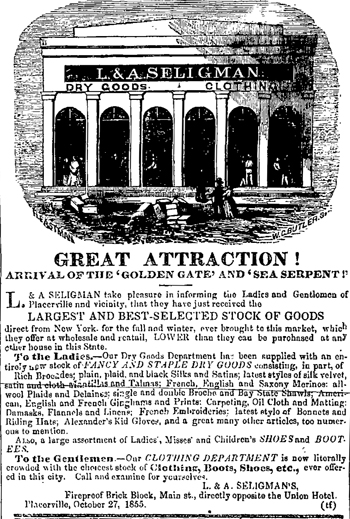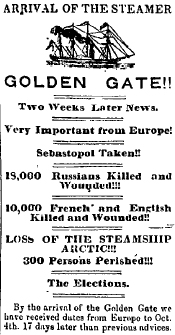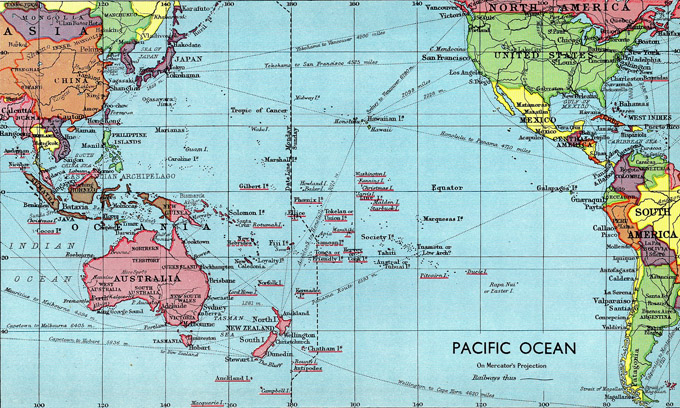Shipwrecks in Pacific Waters: 1800s

° Passenger Ship Arrivals
SS Golden Gate
Builder: William H. Webb, New York. Keel laid July 1, 1850.
Engine: Two oscillating engines by Novelty Iron Works. Wooden side-wheel steamer, 3 decks, 3 masts, round stern, spread-eagle head. 2,067 tons, 269 feet x 40 feet x 30 feet 6 inches. Her wheel diameter was 33 feet 6 inches and she had a draft of 10 feet 2 inches or 13 feet 8 inches loaded.
Her first run to San Francisco left New York in September 1851 and arrived in the City on November 19, 1851. (Note: A second source has her leaving New York on August 2, 1851 via Rio de Janeiro, Valparaiso, and Panama and arriving in San Francisco on November 19, 1851.
San Francisco press hailed her as "the largest and swiftest steamer in our waters," and she was called the "finest specimen of naval architecture on the Pacific." She was seized on September 2, 1852 for taking taking on too many passengers. Apparently, along with the Columbia and SS Lewis, they had been placing more than two tiers of berths in their cabins and steerage.
January 16, 1853, Daily Alta California, San Francisco, California
DEPARTURE OF STEAMERS: The steamers Golden Gate, Winfield Scott and Independence sailed yesterday for Panama. The Golden Gate took nearly seven hundred passengers. Her cabins were completely crowded, she being the favorite boat with the public. The other vessels were also well filled, taking many of our prominent and effective citizens from our shores. We are happy to state, however, that their stay will be limited, they intending to return almost immediately. Many have gone for the purpose of bringing their families out; this is just what we need in California.

Advertisement from the Mountain Democrat, Placerville, California published November 17, 1855 listings goods shipped in on the SS. Golden Gate and Sea Serpent.
Her passage from Panama to San Francisco of eleven days, four hours, stood as a record until 1855. Unfortunately, like SS Brother Jonathan, even though she was fast, she was plagued with problems, including an outbreak of cholera in 1852, which resulted in 29 deaths (a second source reports 84 deaths). In 1853, she nearly collided with the Vanderbilt steamship Sierra Nevada off the coast of Mexico, her shaft cracked twice, and she went aground at Point Loma in 1854.
January 3, 1856, Daily Alta California, San Francisco
TWO STEAMERS--Rates of Passage--Number of Passengers.--The Golden Gate, of the Panama Line, and the Uncle Sam, of the Nicaragua Line, are advertised to sail this morning at 9 o'clock, and will probably got off about noon. The Golden Gate will take between four and five hundred passengers, and her rates of fare are in the First Cabin, $250; Second Cabin, $175; Steerage, $100. The Uncle Sam will have about four hundred passengers, and her rates are in the First Cabin, $225; Second Cabin, $150; and in Steerage, $95. There are a large number desiring to go down to Nicaragua, but up to a late hour yesterday, only twelve tickets had been sold. The parties were holding back for a reduction in the price of passage, which has been fixed for this steamer at $75. The Cortes carried down for $60. Most of these who are negotiating for tickets to Nicaragua are from the interior. The sad news received yesterday of the death of three well known young men from this city has cast a gloom over the wide circle of their bereaved friends, and this intelligence will have a tendency to dampen the zeal for those who may have been longing for the charms of Central America.

January 3, 1856, Daily Alta California, San Francisco
DEPARTURE OF THE STEAMERS.
--The Steamer Golden Gate sailed yesterday, at half past 2 P.M., carrying about 400 passengers and $1,276,928 treasure.
July 27, 1862: Between San Francisco and Panama, about 15 miles from Manzanillo, Mexico, fire was discovered in the engine room, and the vessel was headed for what is now called Playa de Oro to beach. Many of the passengers sought refuge in the stern, but the flames spread in that direction, and when boats were launched in the heavy surf the occupants were crushed against the ship or drowned; the ship broke up in the surf. Reports of between 175 and 223 passengers and crew lost their lives, together with the baggage, mail, and nearly all the cargo of $1.4 million in specie. Survivors arrived in San Francisco in August, and the Daily Alta California published reports of the disaster from those survivors and from Capt. W.W. Hudson and Capt. R.H. Pearson. August 6, 1862, Received August 7, 1862, 11:45 a.m. W.L. Halssy, care of Geo. K. Otis, 88 Wall Street:, New York.
I was saved from the burning ship by lashing myself to the forecastle ladder. I then jumped overboard; passing under the port wheel while the vessel was still underway. Fortunately I sustained no serious injury, and was picked up by the ship's boat. We were in the boat fully 20 hours before reaching Manzanilla. Poor Flint was lost. -- BEN J. HOLLADAY
Holladay's injuries weren't severe, but references by others make it clear that he didn't pass under the wheel uninjured. Mrs. Thomas Gough, rescued in one of the lifeboats, was dining with Capt. Hudson when the word came to his table of a fire aboardships. "Oh, nonsense! I don't believe it," he responded to the sailor with the news, but immediately left the table to investigate. She was in one of the first boats launched, which tossed all aboard into the sea during the failed lowering. A sailor jumped into the water, then righted the boat, after which the boat reloaded. The boat eventually began to take water, but encountering the boat of Mathew Nolan, first mate, he ordered the survivor to use a portion of Mrs. Gough's dress and handkerchiefs to top the leak.

Nolan also organized the boats together, as several were launched while the Golden Gate was still about two miles from shore. "The first mate then ordered one of the boats to go back and taken the surplus boats in tow, and follow in the wake of the ship, which was headed for the shore," another account in the Daily Alta California relates. "All the after part of the ship was now one sheet of flame, and her passengers were all crowded into the bow."
"By the time we had reached the ship, many were ashore. After rowing about the ship until we could find no more floating there, we then went back, still searching for those who had left the ship before she struck, and found some five or six who were floating upon boards and timbers, among whome were Ben Hollday and Mr. Storms." There were a number of men floating in life preservers; Mrs. Gough's boat was full with 28 people, so those swimming to the boat were told to hang onto the sides. They rowed through the night for Manzanillo, encountering a thunderstorm around midnight. Finally the boat reached harbor around 1:30 p.m. on Monday. Other lifeboats continued to arrive through the afternoon.
Gold valued at $300,000 was recovered from the wreck and brought to San Francisco by the Pacific Mail steamship Constitution in February 1863.
January 23, 1863, Daily Alta California, San Francisco
From the Wreck of the Golden Gate
The pilot boat Potter, of San Francisco, arrived here on Sunday last from Manzanillo, having recently visited the wreck of the steamship Golden Gate. T.J.L. Smiley, of San Francisco, who was one of the party accompanying the the pilot boat on her expedition to the wrecked steamer, has given us some interesting particulars of the excursion. Mr. Smiley says portions of the wreck are still visible, but from observations made around and about it, he is of opinion that the sides of the vessel must have given way since the wreck, and that the treasure aboard the ill-fated steamer has drifted out, and been buried in the sand. The New York and foreign underwriters had been to the wreck endeavoring to obtain the treasure, but had abandoned the enterprise before the Potter reached the ground.
Mr. Smiley also gave us an interesting account of a man names Yates, an old resident of Manzanillo, who has been near the wreck a greater part of the time since the steamer was burned. About ten days after the disaster, Yates, prompted by a desire to recover the steamer's treasure, went to the beach near where the wreck occurred, and there erected a tenement, in which he now lives. His hopes of obtaining the treasure not having been realized, he has devoted himself to the humane occupation of interring much of the lost by the sad disaster as he might chance to fall in with. Yates keeps a careful record of each body interred by him, taking from each an article of clothing or other mark of identification, to which he gives a number corresponding to the number of the grave in which the body is buried, and thus is enabled to assist materially such parties as may be in search of the remains of lost kindred or friends.
One instance only of the efficacy of Yates' plan of procedure we will mention in detail: Mr. Isaac Josephi, of San Francisco, had a brother who was among the lost by the Golden Gate disaster. Immediately after learning the sad intelligence of his brother's death, Mr. Josephi telegraphed New York to ascertain if there was any particular mark about the deceased which would aid in identifying the body. In reply he was told that his brother had had some teeth inserted by a dentist, who had placed a certain number upon the gold plate used by him. With this information, Mr. Josephi started for the wrecked steamer, and on his arrival at the scene of the disaster, he sought and obtained an interview with Mr. Yates, and ascertained that the latter had taken the gold plate from the mouth of the deceased, and had numbered it correspondingly with the number of the grave in which he had placed the remains. This enabled Mr. Josephi to recover his brother's body without further difficulty. Such humane conduct as Yates has displayed is certainly commendable in a high degree, and we trust that for the troubles and privations he has sustained in his no less singular than humane undertaking, he may meet with a commensurate rewards.
Mazatlan Cosmopolitan, Jan 1st.
Sunday, February 8, 1863, Daily Alta California, San Francisco, California, U.S.A.CITY ITEMS
Recovery of part of the Golden Gate's Treasure
The steamer Constitution, which arrived yesterday, touched at Manzanillo on her upward trip, where she took aboard a large amount of specie, consisting of Mexican dollars. After leaving that harbor, the steamer ran down to the scene of the wreck of the Golden Gate. Here fifteen boxes, containing the sum of $820,000, being a portion of the treasure sunken on that ill-fated vessel, were taken on board. This unexpected recover was effected by the party which sailed from this port two month since, on the clipper schooner William Irelan. The gentlemen of that name was the superintendent of the enterprise, and with him a party of ten assistants. The dumb agent, which took the most active part in the securement of the money, was Commodore Allen's steam engine, called the Andrew Jackson. This being fastened on a scow, was run into the breakers and secured. The water here is about twelve feet deep. The dredger was then set in motion and the dredging process began. The engine worked so quickly and powerfully that twenty-eight hundred pounds of sand or other materials were raised per minute by the dredger.
This work was done over the supposed locality of the treasure vault, which, although broken up, the boxes would, of course remain in a narrow compass. The sand being partially removed, the diver would descend; and finding a box, fasten it ot the lines, when the machinery would hoist it aboard. A steam pump and hose were also used in cleaning off the sand from the submerged boxes. The weather was fine, sea calm, and everything favorable for continued successful operations.
After seven days labor the sum of $820,000 was secured, and when the Constitution left, the work was progressing so favorably as to justify the sanguine expectations of the Company, who believe that a million of treasure will be saved. We have been informed that a number of the boxes as soon as hoisted, were seized by a bank of prowling Mexicans and bore off. The amount thus stolen, as represented to us, was $200,000. The Constitution passed within two or three ships' length from the wreck. The schooner lay at anchor some fifty or sixty yards from the shore. It is not impossible that the entire amount of treasure still buried will be recovered within the 60 days next ensuing. The sum brought up on the steamer, and which belongs to the enterprising experimentists of the city was duly deposited in the banking house of Parrott & Co. We are not surprised that other unsuccessful parties, who had embarked heavily in a similar expedition, feel somewhat chagrined that they came so near reaping the first fruits of their pioneer efforts in endeavoring to draw up the drowned dollars.
New York Times, Saturday, August 9, 1862, New York, New York
Passengers and Crew Saved (from 242 passengers and 95 officers and crew):
First Cabin.
Ben Holliday
J. Whitney, Jr.
A.J. Nichols
J.C. Joughaus and wife
A. Chavanne
C. J. Fox
B.L. Schmidt
Mrs. D. A. Hurse
O. Given (boy, 2 years old)
Capt. R. H. Pearson
?. Given (8 weeks old)
Abel Guy
Mrs. W. T. Gough
Mrs. Walkie
S. M. Murphy and wife
A. J. Gunnison
Geo. O. Mullen (lost wife and children)
H. Turpllin
Miss A. A. Manchester (8 years old)
Miss E. C. Manchester (5years old)
Frank Manchester (3 years old)
Second Cabin.
T. F. Haywood
O. Bradley
G. T. Berthaniel
Geo. Fulton (7 years old)
Mrs. S. Francis
Felix Besson
Gerba W. Walker
John Jenkins
G. W. Chase
Jane G. Forsyth, servant to Mrs. Greene
Isaac L. Gear
R. H. Dorsey
P. H. Moran
Mrs. O. J. Ross
S. C. Todd
John (or Jonas) (4 years old)
W. R. Wilcox
C.C. Thomas
G. Matindl
Dr. Lickey
Wm. Hamilton, Ben Holladay's servant
John H. Booth (13 years old)Steerage.
C. W. Follansebee
J. Swords
R. Perry
W. Henseal
John Smith
Wm. Henry
E. C. Banker
Phillip Class
Leo E. Emerson
J. Spencer
John Dillon
A. Fisher
R. Cooper
H. A. Allen
O. P. Darling
J. M. Murphy
E. J. Haskell
H. C. Morton
R. Leslie
W. Woodworth
J. Tisal
J.N. Beveridge
James Antoine
J. H. Mitchell
A. H. Bates
P. M. Kearney
N. Walby
S. A. Mann, Sergant, U.S.A.
B. C. Ircoac
J. O. Garber
John Chart
Captain Hudson
Mr. Waddell, Chief Engineer
Purser Wood
Mr. Flint (lost)
Dr. Jones (lost)
William HowdOFFICERS AND CREW.
W. H. Hudson, Captain
W. Waddell, Chief Engineer
Mathew Nolan, Frist Mate
H. McKinney, Second Mate
J. K. Wood, Purser 58 others.The names of the lost will be telegraphed as soon as procured.
Mr. Flint, of Holladay & Flint, Dr. Janes, and Mr. and Mrs. Griffin, of Baltimore, are known to be lost. Four children of the latter were saved.

Great Shipwrecks of the Pacific Coast
Author Robert Belyk examines ten significant maritime disasters that occurred during one of the most turbulent eras in the history of travel. Real-life drama endured by those caught in the terrifying midst of disaster at sea and the causes behind the tragedies. Well researched, the shipwrecks accounted for here include:
- 1854: the Yankee Blade runs aground. Twenty-eight passengers lose their lives.
- In 1865, only 19 of the 204 passengers and crew on board survived the wreck of the Brother Jonathan, whose owners had been more concerned with maximum profitability than with the safety of their passengers.
- 1875: The old side-wheeler Pacific rams another passenger ship off the coast of Cape Flattery, Washington. Two hundred and seventy-seven people perish when her rotting hull gives way.
- 1906: The Valencia strikes a reef off the Washington coastline. Before dozens of dazed onlookers on the shore, the ship goes down taking 117 passengers and crew with her.
- 1907: The Columbia disappeared under the ocean surface in just eight minutes after ramming another passenger ship. Her poorly maintained iron hull simply gave out, leading to the deaths of 87 passengers.e Organization of American Historians. Benefitting from hundreds of primary sources, dozens of captivating images and reflective of the latest trends in the field.

 Copyright ~ 1998-2018.
Copyright ~ 1998-2018. 